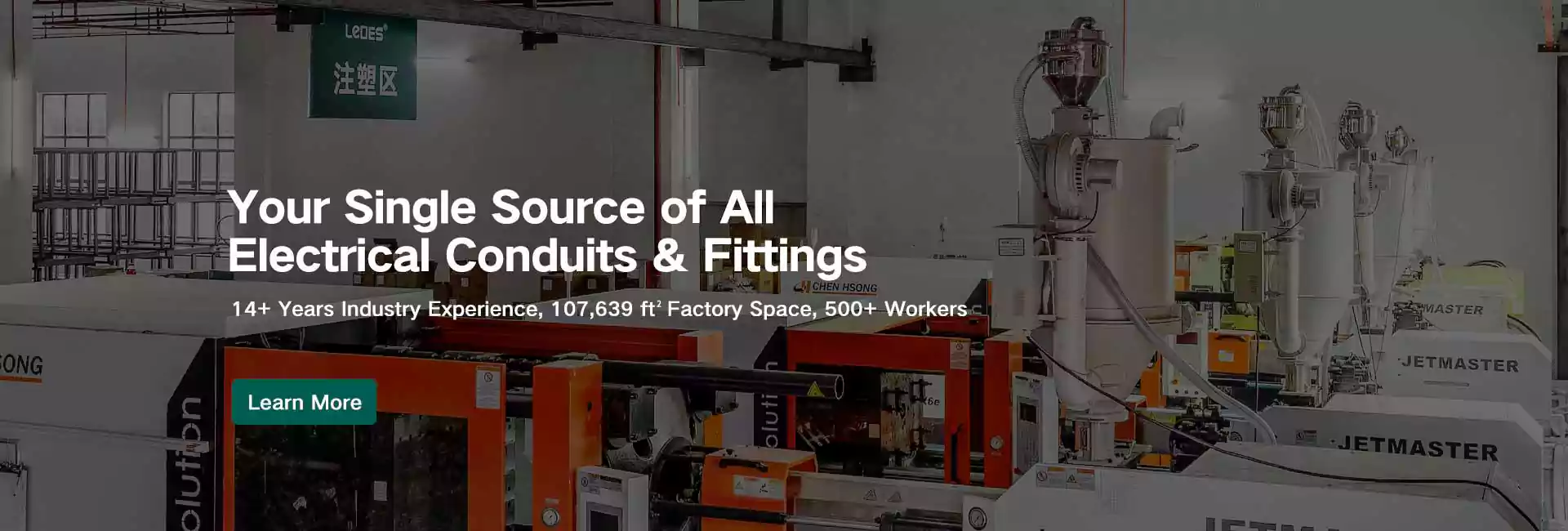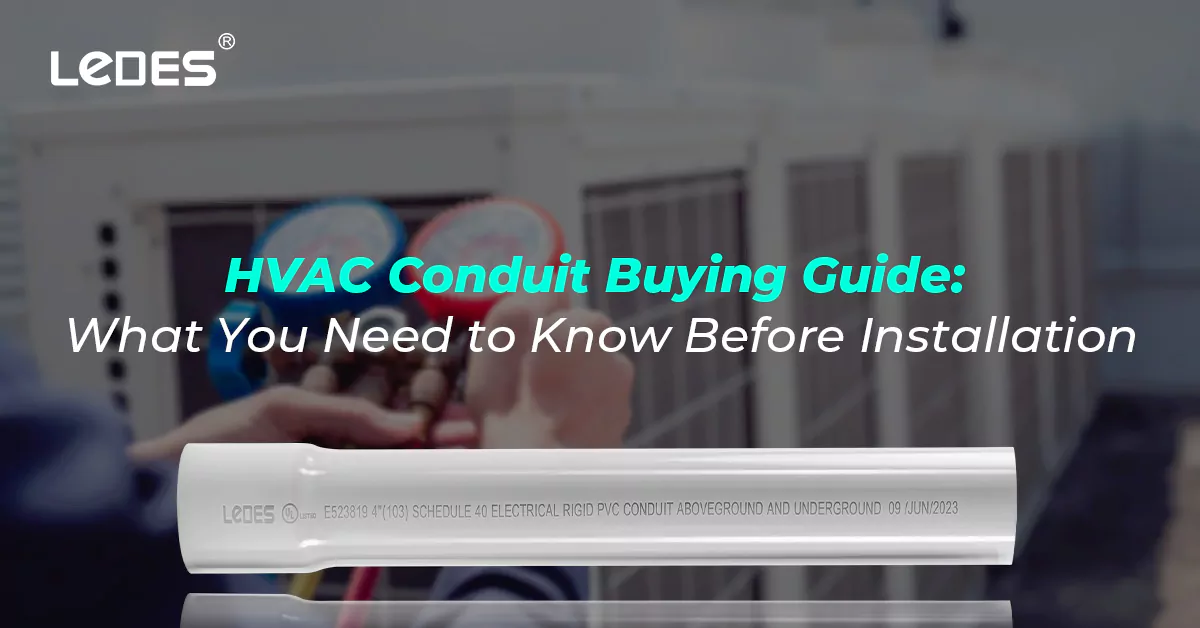
Table of Contents
1. Introduction
If you think of an HVAC system as the lungs of a building, then the conduit is like the arteries and veins that keep everything connected and protected.
Heating, ventilation, and air conditioning together create comfort and stability in homes, offices, and factories.
But to operate smoothly, these systems rely on a hidden network of pathways that shield and guide the wires and pipes carrying power and signals. This hidden network is what we call HVAC conduit.
At first glance, conduit may seem like a simple tube, but its role is fundamental. It ensures that wiring remains safe from heat, moisture, and physical damage, while also helping the entire system meet building codes and safety standards.
In other words, conduit is not just about neat installation—it’s about ensuring reliability and safety in the long run.
Whether you’re an engineer, a contractor, or simply planning your next installation, understanding conduit will give you a clearer view of how HVAC systems work behind the scenes.
In this post, we will explore what HVAC conduit is, the basic theory behind it, the different types you may encounter, why it matters for system performance, the relevant codes and standards, and practical advice on how to choose the right option for your project.
- HVAC conduits protect and organize electrical wiring within heating, ventilation, and air conditioning systems.
- Proper conduit selection ensures safety, efficiency, and compliance with electrical codes.
- Understanding conduit theory, material types, and installation practices helps prevent future maintenance and system failures.
- The right conduit system supports long-term reliability and cost-effective operation in both residential and commercial HVAC applications.
2. What Is HVAC Conduit?
HVAC Conduit Definition
At its core, conduit is a hollow channel—usually made of plastic or metal—designed to protect and route electrical wiring.
But when we talk specifically about HVAC conduit, the meaning becomes narrower and more specialized. It serves as the dedicated pathway that carries and protects power and control lines connecting different HVAC components such as air handlers, compressors, thermostats, sensors, and rooftop units.
In other words, HVAC conduit is what links the entire system together—allowing electricity and control signals to move safely between equipment spread across mechanical rooms, ceilings, and rooftops.
Think about what an HVAC system goes through on a daily basis:
Heat exposure from furnaces, boilers, and rooftop units.
Moisture and condensation from cooling coils and chiller pipes.
Mechanical stress and vibration from compressors and fans.
Outdoor conditions such as UV radiation, rain, and fluctuating temperatures.
Ordinary conduit may suffice for general electrical wiring, but HVAC conduit must meet a higher standard. It is not only a protective cover—it functions like specialized armor, built to handle a dynamic and sometimes hostile environment.
Summary
Different materials bring different strengths:
Conduit Type | Material Characteristics | Typical HVAC Applications |
Non-metallic, lightweight, affordable, and corrosion-resistant. | Outdoor runs and exposed areas where UV resistance is required. | |
uPVC (Unplasticized PVC) Conduit | More rigid than PVC; offers better mechanical strength and higher heat tolerance. | Areas requiring durability and impact resistance, such as mechanical rooms or rooftop installations. |
PPR (Polypropylene Random Copolymer) Conduit | High temperature and pressure resistance; suitable for hybrid systems. | HVAC systems integrating electrical conduits with hot or chilled water lines. |
PEX (Cross-linked Polyethylene) Conduit | Extremely flexible, resistant to freezing, scaling, and chemical corrosion. | Modern HVAC designs that combine plumbing and electrical protection pathways. |
Metallic Conduits (EMT, RMC, FMC) | Strongest mechanical protection; excellent grounding and shielding capability. | Industrial or commercial HVAC systems where code requires metallic protection. |
In summary, HVAC conduit isn’t just “a tube for wires.” It’s an integral component that ensures electrical safety, durability, and system connectivity across demanding environments. Understanding this foundation is the first step before exploring the theoretical basics and classifications of conduit types.
3. Theoretical Basics of HVAC Conduit
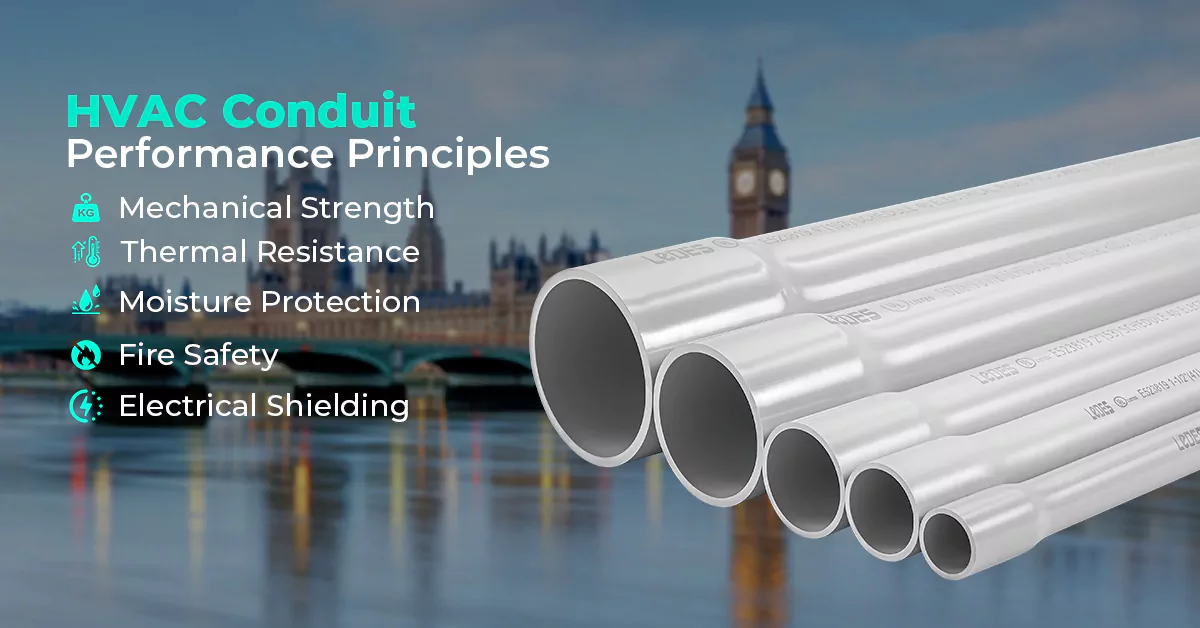
When we speak of conduit in HVAC systems, it’s easy to think only of material choices or product categories. But behind every specification lies a set of theoretical principles that explain why conduit needs to perform the way it does. These principles—mechanical strength, environmental resilience, fire safety, and system compatibility—form the foundation for every decision an engineer or contractor makes.
3.1 Mechanical Integrity and Structural Design
A fundamental requirement of HVAC conduit is to provide consistent physical protection for wiring and, in some cases, secondary piping. This protection is not just about preventing accidental bumps; it’s about maintaining integrity under compression, vibration, and impact loads.
Compression and load-bearing: Conduits installed in mechanical rooms or ceilings may be exposed to weight from other utilities. Their wall thickness and rigidity must prevent collapse.
Vibration resistance: HVAC systems generate constant vibrations from fans, compressors, and pumps. Without proper conduit strength and fastening, these vibrations can lead to premature wear at joints or cracks along the conduit.
The design theory here is similar to structural engineering: the conduit acts like a small-scale beam, absorbing and redistributing stress to protect the sensitive wiring inside.
Pro Tips: Want to learn more about the collapse test and electrical code requirements? Click the link above to read our expert insights.
3.2 Thermal Performance and Temperature Tolerance
Temperature is another critical factor. HVAC systems deal with extremes—chilled air that can drop below freezing and heated air that can rise well above 100 °C in localized areas. Conduit must be selected with thermal expansion, contraction, and material stability in mind.
Expansion and contraction: Plastic conduits like PVC and PPR naturally expand when exposed to heat. If not accounted for with expansion joints, they may buckle or crack.
Heat resistance: Materials must retain mechanical strength at elevated temperatures. Metallic conduits handle this well, but non-metallic options require formulation (e.g., uPVC with added stabilizers) to prevent deformation.
The theory here aligns with material science: the coefficient of thermal expansion dictates how a conduit reacts to temperature cycles, and failure to consider it can lead to both electrical and mechanical failures.
3.3 Moisture and Environmental Protection
HVAC systems frequently operate in humid or wet environments. Condensation on cooling coils, leaking valves, or even outdoor weather conditions can expose conduits to continuous moisture. From a theoretical standpoint, the conduit must act as a sealed barrier that prevents water ingress, because even small amounts of moisture can compromise insulation resistance and trigger faults.
Nonmetallic conduits (PVC, uPVC) inherently resist corrosion but may require watertight fittings.
Metallic conduits must often be galvanized or jacketed to prevent rust.
In this sense, conduit design borrows from fluid dynamics: the path must be continuous and sealed, ensuring that water cannot accumulate or penetrate into the wiring space.
3.4 Fire and Safety Considerations
Conduit also plays a defensive role in fire protection. Wiring pathways can act as channels for flame spread if not properly contained. Theoretical safety requirements include:
Flame-retardant properties in plastics, which slow the spread of fire along the conduit.
Grounding through metallic conduits, which prevents electrical faults from becoming fire hazards.
Maintaining compartmentalization in fire-rated walls or ceilings, ensuring conduit penetrations don’t create weak points in fire barriers.
This principle is rooted in fire dynamics and building safety codes: conduits are part of the passive fire protection system of a building.
Notes: Do you know UL’s six fire ratings? Why are fire ratings so important for PVC conduit? Click the link above to read our expert guide and become an industry expert.
3.5 Electrical Compatibility and Signal Integrity
Beyond mechanical and environmental roles, conduits also influence electrical performance. HVAC systems rely not just on power wiring but also on control and communication signals (such as thermostats, sensors, or automation systems).
Shielding effect: Metallic conduits can reduce electromagnetic interference (EMI), protecting sensitive control signals.
Segregation of circuits: Conduits help organize different voltage levels, reducing the risk of interference or accidental contact.
This principle comes from electrical engineering: the conduit is not just a pipe but also a controlled environment that improves reliability of signal transmission.
4. Purpose of HVAC Conduit & Why It Matters
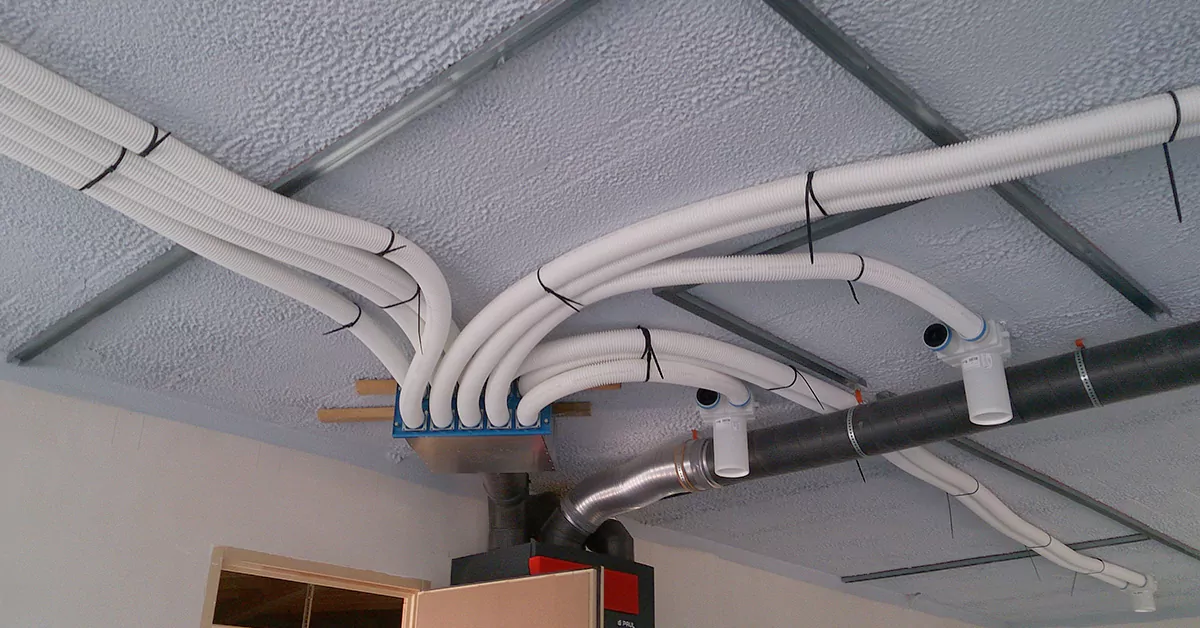
As mentioned in our previous section regarding the relevant application scenarios of HVAC conduit, we can understand its purpose. HVAC conduit lies in the way it ensures safety, reliability, and long-term performance of the entire system.
4.1 Protection of Wiring and Components
HVAC systems rely on a web of electrical wiring to power motors, sensors, and control units. Without proper conduit, these wires would be exposed to mechanical damage, heat, and moisture. For example, a rooftop chiller exposed to sunlight and rain can quickly degrade unprotected wires. Conduit acts as a protective shield, preventing physical wear and environmental exposure from leading to costly failures.
4.2 Ensuring Safety and Reducing Hazards
Conduit also plays a vital role in protecting people and property. Exposed wires increase the risk of short circuits, electrical fires, or accidental contact. Metallic conduits provide grounding, while flame-retardant plastic conduits help slow fire spread. In this sense, conduit is a silent safety system—rarely noticed when it’s working, but critical in preventing disasters.
4.3 Enabling Efficient System Performance
A well-organized conduit network keeps wiring pathways structured and accessible. This is particularly important in HVAC installations where space is limited, such as mechanical rooms or above suspended ceilings. By maintaining orderly wiring, conduit reduces the risk of tangling or misrouting, which in turn supports system efficiency and easier troubleshooting.
4.4 Supporting Code Compliance and Inspection
Regulatory standards require proper conduit use in most HVAC installations. For instance, the NEC (National Electrical Code) specifies mechanical protection and segregation of wiring in HVAC systems. Using the right conduit ensures that projects pass inspection smoothly, which is crucial for legal approval, warranty validity, and insurance coverage.
4.5 Extending System Lifespan
Finally, HVAC conduit contributes directly to long-term system durability. By reducing wear and protecting electrical connections, it minimizes maintenance costs and extends the lifespan of both wiring and equipment. Over the life of a building, this preventive role can represent significant cost savings.
5. Codes and Standards for HVAC Conduit
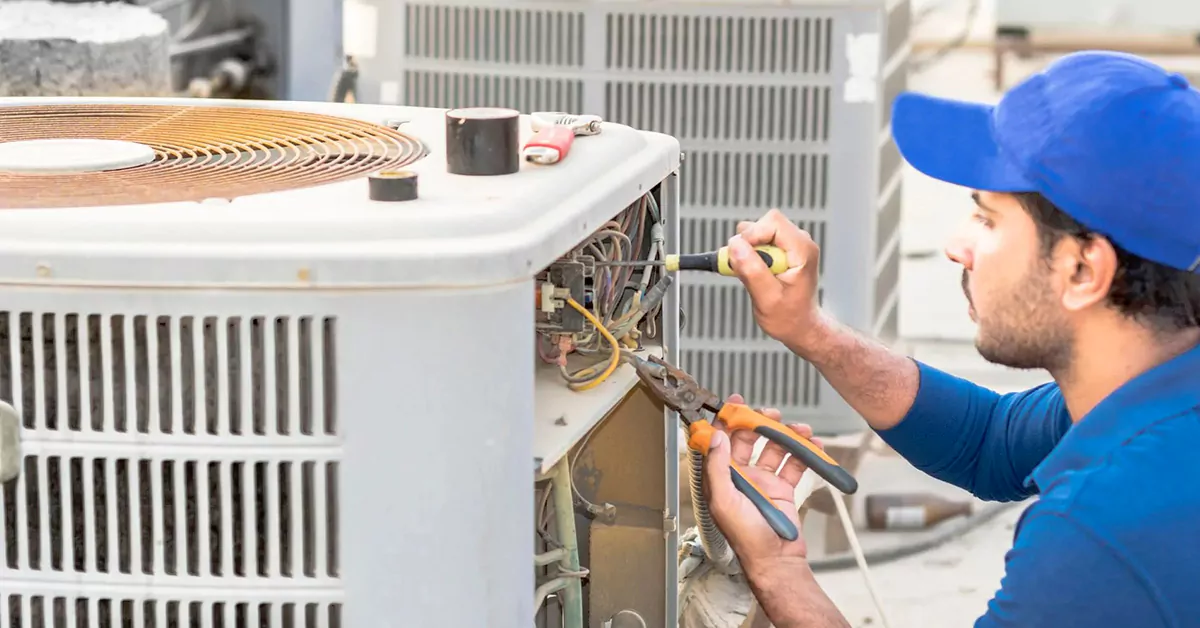
When it comes to HVAC conduit, compliance with codes and standards is not optional—it is a prerequisite for safe and lawful installation. While the function of conduit is to protect wiring, its use is closely tied to regulatory frameworks that specify how, where, and why different types of conduit must be applied.
5.1 The Role of Codes in HVAC Installations
HVAC systems are unique compared to other electrical installations. They often involve:
High current equipment such as compressors, motors, and pumps.
Distributed wiring systems that stretch across rooftops, mechanical rooms, and sometimes underground.
Environmental challenges, including moisture, vibration, and exposure to chemicals.
Codes provide a framework to ensure that conduit in these environments offers consistent levels of safety and performance. Without such guidelines, installations would vary widely in quality and reliability, making inspection and long-term operation unpredictable.
5.2 North American Standards: NEC and CEC
In North America, two major codes govern the use of conduit in HVAC:
NEC (National Electrical Code, U.S.)
Requires mechanical protection for conductors in HVAC systems, particularly for rooftop and outdoor units.
Defines conduit types suitable for different conditions (e.g., rigid metallic conduit for high-exposure zones, PVC conduit for underground applications).
Stresses grounding requirements and protection against corrosion or UV degradation.
Pro Tips: Are you still searching for the latest information on the NEC code? Click the link above to read the ultimate guide.
CEC (Canadian Electrical Code)
Similar to NEC in principle but with added emphasis on cold weather performance of conduit materials.
For example, nonmetallic conduits in Canada are often tested for impact resistance at sub-zero temperatures, a factor less prominent in U.S. codes.
Also regulates conduit connections to HVAC junction boxes and specialized fittings.
Notes: Want to learn about the latest CEC version of electrical wiring insatllations? Click the link above to read the latest definitive guide.
5.3 International Perspectives
Outside of North America, HVAC conduit standards are influenced by broader electrical installation rules:
IEC (International Electrotechnical Commission) standards provide general requirements for conduit systems, focusing on dielectric strength, flame spread, and mechanical durability.
European Union Directives (EN standards) include energy efficiency and fire safety considerations, which affect conduit selection in HVAC environments such as commercial buildings or hospitals.
Middle East and Southeast Asia often adopt a mix of IEC-based standards with local amendments that stress flame resistance, reflecting the hot climate and dense urban building codes.
5.4 Application-Specific Requirements in HVAC
Beyond general electrical rules, HVAC conduit is subject to application-driven codes:
Plenum spaces (areas used for air circulation) require conduit with low smoke and halogen-free properties to prevent toxic emissions during a fire.
Outdoor rooftop units require UV-resistant conduit to withstand long-term exposure to sunlight.
Underground runs for chillers or large air handling units must use conduit rated for burial and moisture resistance.
Mechanical rooms may require conduit rated for corrosion resistance due to chemical cleaning agents or high humidity.
6. Buying Guide for HVAC Conduit
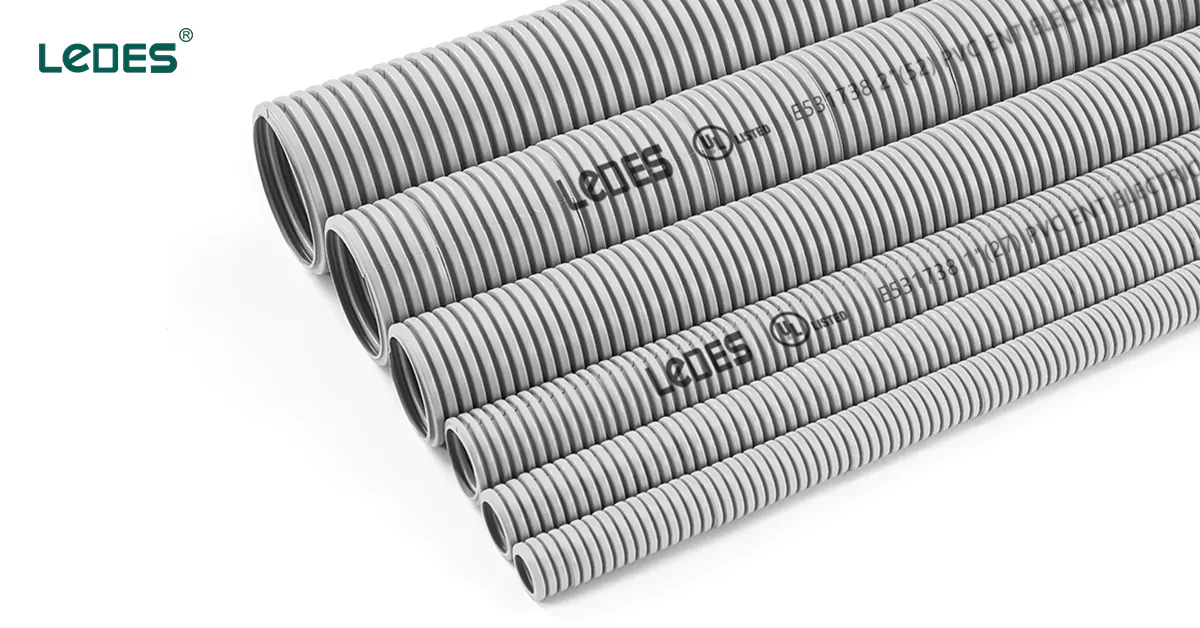
Choosing the right conduit for HVAC systems is not a one-size-fits-all decision. Each project involves unique environmental conditions, performance expectations, and cost considerations. A good buying decision balances compliance, durability, and efficiency.
6.1 Know Your Environment Before Choosing
The environment where the conduit will be installed is the first filter in any decision:
Indoor, conditioned spaces – Lightweight conduits like EMT or PVC are often sufficient, provided they meet plenum and fire-rating requirements.
Outdoor and rooftop applications – UV-resistant PVC or coated steel conduit is recommended to withstand sunlight and temperature swings.
Underground runs – Use watertight and corrosion-resistant conduit (PVC Schedule 40/80 or RTRC) for long-term performance.
High-humidity or chemical-exposed areas – Nonmetallic conduits that resist rust and chemical attack are better suited than bare metal options.
Understanding environmental stressors upfront reduces the risk of premature failure and costly retrofits.
6.2 Compare Materials by Performance and Cost
Different conduit materials come with trade-offs in mechanical strength, flexibility, and price.
PVC (Polyvinyl Chloride) – Lightweight, corrosion-resistant, and cost-effective; widely used in underground and outdoor HVAC wiring.
EMT (Electrical Metallic Tubing) – Thin-walled steel; affordable and easy to bend, best for indoor mechanical room or wall-mounted runs.
RMC/IMC (Rigid/Intermediate Metallic Conduit) – Heavy-duty, ideal for areas prone to physical impact or high-security installations.
RTRC (Reinforced Thermosetting Resin Conduit) – Combines strength with light weight; excellent for long underground runs.
Flexible Conduits (LFNC or FMC) – Used where vibration, movement, or space constraints exist, such as near HVAC units.
Contractors often mix these materials across the same project, using each where it performs best.
6.3 Check Code Compliance and Certification
No matter how good the material seems, it must meet local codes:
UL and CSA listings verify compliance for U.S. and Canadian projects.
Fire and smoke ratings (such as plenum-rated, LSZH) are critical for ducts running in air-handling spaces.
NEC/CEC approvals dictate acceptable usage in rooftop, underground, and damp environments.
Always verify markings on the conduit and fittings to avoid inspection delays.
6.4 Balance Budget with Long-Term Reliability
It’s tempting to choose the cheapest option, but HVAC conduits are long-term infrastructure investments. A slightly higher upfront cost can:
Extend system lifespan by resisting corrosion or UV damage.
Reduce downtime caused by wiring failures.
Lower maintenance costs over time.
In critical facilities—like hospitals, data centers, or airports—reliability often outweighs initial savings.
6.5 Common Buying Mistakes to Avoid
Ignoring environmental ratings – A conduit not rated for UV or cold weather may crack within years.
Overusing one type – EMT everywhere may save cost but fail in outdoor or underground sections.
Neglecting fittings and accessories – Even the best conduit fails without watertight, code-compliant connections.
Not planning for expansion – Undersizing conduits leaves no room for future wiring upgrades.
Being proactive in selection avoids rework and ensures smoother inspections.
6.6 Partnering with Reliable Suppliers
Finally, choose suppliers who:
Provide consistent quality and verified certifications.
Offer a broad product range (PVC, EMT, RMC, flexible options) for different needs.
Maintain strong delivery capability, ensuring no project delays.
Support customers with technical guidance on conduit selection and compliance.
A good supplier is more than a seller—they are a partner in ensuring system safety and efficiency.
Ledes is one such trusted partner. As a professional PVC conduit supplier, Ledes provides a complete range of electrical conduit systems including rigid conduit such as Schedule 40 & 80, and flexible conduits. Also provides matching fittings. With UL, CSA, and IEC certifications, Ledes ensures consistent product quality and compliance.
7. Installation Best Practices for HVAC Conduit
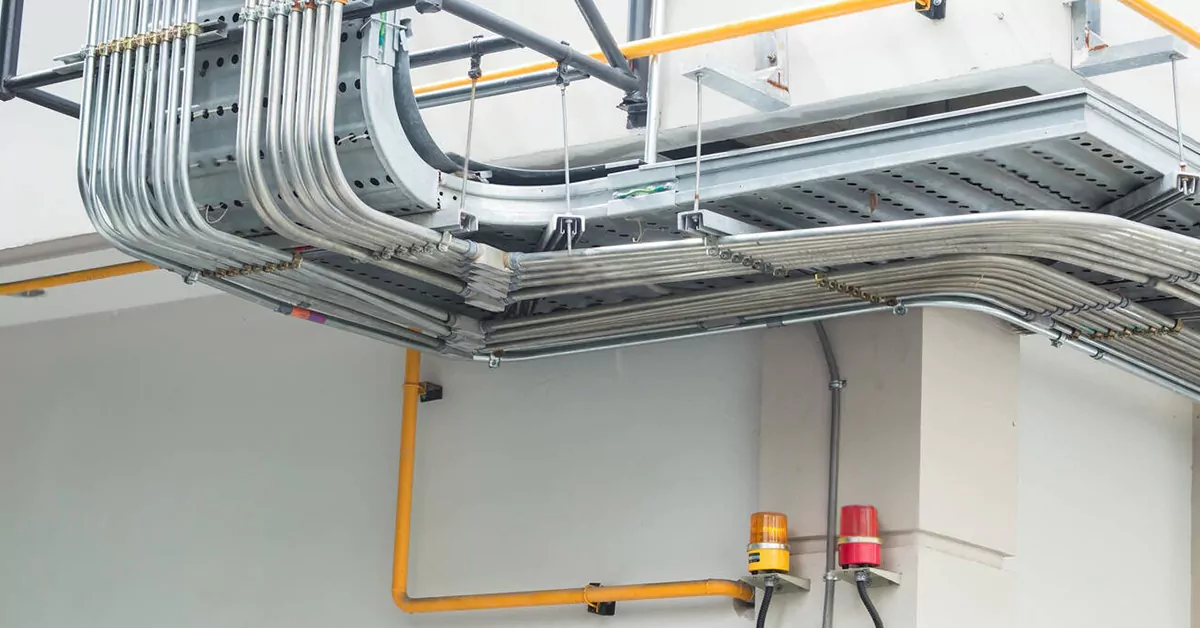
Even the best conduit can fail if not installed properly. HVAC environments involve vibration, moisture, temperature changes, and limited space — all of which demand careful installation to ensure long-term safety and performance.
7.1 Plan and Prepare
Before starting, map conduit routes for efficiency and accessibility.
Minimize unnecessary bends to reduce pulling resistance.
Avoid blocking HVAC service panels or maintenance zones.
Use expansion fittings for PVC runs exposed to temperature swings.
Separate power and control wiring to prevent interference.
Good planning minimizes rework and ensures NEC/CEC compliance.
7.2 Apply Proper Tools and Techniques
Choose bending and connection methods suited to each conduit type:
PVC: Use heated bending boxes or factory elbows to prevent cracks.
EMT/Steel: Use precision benders for smooth radii.
Flexible: Secure with strain-relief connectors to prevent loosening.
Avoid forcing bends or overtightening fittings, which can weaken protection.
7.3 Ensure Solid Support and Sealing
Support conduits according to code (e.g., EMT within 3 ft of a box and every 10 ft thereafter). Use corrosion-resistant hangers in damp or rooftop areas, and add extra supports near vibrating equipment.
In outdoor or humid environments, seal all fittings and entries with watertight connectors or sealing compounds. Always maintain grounding integrity for both metallic and nonmetallic systems.
7.4 Inspect and Prepare for the Future
After installation, test cable pulling, check bends and supports, and verify labeling. Keep documentation for code compliance and future service.
Plan ahead by using slightly oversized conduits, adding accessible junction boxes, and recording conduit routes — ensuring easy upgrades and maintenance later.
8. Maintenance and Troubleshooting for HVAC Conduit
HVAC conduit systems are built for long-term performance, but regular maintenance and timely troubleshooting are essential. Small issues like loose fittings, cracks, or corrosion can lead to electrical faults and safety risks. A consistent maintenance plan ensures the system remains reliable under vibration, moisture, and temperature stress.
8.1 Routine Inspections
Perform regular visual and functional checks:
Look for cracks in PVC, rust on steel, or deformation from impact.
Verify fittings and seals remain watertight in outdoor or rooftop runs.
Check that supports and clamps are secure and corrosion-free.
Confirm grounding continuity in metallic conduits.
Commercial HVAC systems typically follow quarterly inspections, while critical sites may inspect monthly.
8.2 Preventive Maintenance
Proactive care extends service life and prevents downtime:
UV Protection: Apply coatings or shields on outdoor PVC.
Moisture Control: Inspect sealants and drains to prevent water ingress.
Vibration Management: Ensure flexible sections near compressors stay tight.
Thermal Expansion: Check that expansion fittings move freely in rooftop runs.
Preventive action is always more cost-effective than reactive repair.
8.3 Common Issues and Fixes
Recognizing typical conduit failures allows quick response:
Cracked PVC: Replace with cold-weather-rated or RTRC conduit.
Rust on EMT/RMC: Clean and recoat; replace if severe.
Water Buildup: Add drains or reseal connections.
Loose Joints: Retighten and confirm grounding continuity.
Overfilled Runs: Use larger conduits or add circuits.
Early correction avoids system-wide electrical faults.
8.4 Documentation and Records
Maintenance effectiveness depends on clear documentation:
Keep detailed logs of inspections, repairs, and replacements. Update conduit route drawings after modifications, and track recurring problems to reveal design or environmental weaknesses. Good records simplify future troubleshooting and support compliance audits.
8.5 Troubleshooting for Reliability
When HVAC systems fail, inspect conduits as part of diagnostics:
Check physical and grounding integrity.
Test continuity and insulation resistance.
Review maintenance history for known stress points.
Many electrical faults trace back to conduit issues—fixing them often restores full HVAC function without replacing equipment.
9. Conclusion
As this guide has shown, conduits are far more than just “pipes for wires.” They are essential to HVAC system reliability, energy efficiency, and long-term safety.
While conduits may not be the most visible part of a building, they play a crucial role behind the scenes—protecting electrical wiring from heat, moisture, and mechanical stress while ensuring compliance with safety standards. Choosing the right conduit type, installing it properly, and maintaining it over time keeps HVAC systems operating smoothly and efficiently.
At Ledes, we’re committed to supporting our customers with complete conduit solutions for modern electrical systems. To better serve growing market needs, we’ve also launched new production lines for PPR and PEX pipes—a response to many customer requests for high-quality water piping systems.
Whether your project requires electrical conduits or water piping, Ledes provides reliable, certified, and performance-driven solutions to help you build safely and efficiently.
FAQs

Why is PVC conduit commonly used in HVAC systems?
PVC conduit is lightweight, corrosion-resistant, and easy to install, making it ideal for indoor and outdoor HVAC wiring. It protects against moisture, chemicals, and general wear, especially on rooftops, in mechanical rooms, or underground runs.
Can PVC conduit handle temperature changes in HVAC environments?
Yes. PVC performs well across a wide temperature range, but thermal expansion must be considered. Use expansion fittings and proper spacing in rooftop or outdoor installations to accommodate movement.
What’s the difference between Schedule 40 and Schedule 80 PVC conduit for HVAC use?
Schedule 80 has thicker walls for higher impact resistance, suitable for exposed or heavy-duty areas. Schedule 40 is sufficient for most standard HVAC applications with minimal physical stress.
How can I ensure a watertight and compliant PVC conduit installation?
Use UL/CSA-listed fittings, watertight connectors, and solvent cement joints in damp or outdoor areas. Support conduits according to code spacing and avoid overbending to prevent cracking.
How often should PVC conduit be inspected or maintained in HVAC systems?
Inspect conduits regularly—typically quarterly for commercial sites—for cracks, UV damage, or loose fittings. Applying UV-resistant coatings and checking junction box seals helps extend service life.
What is the HVAC tubing called?
HVAC tubing can refer to electrical conduits or pipes for refrigerant, water, or gas. Electrical wiring typically uses PVC, EMT, or metallic conduits, while refrigerant lines use copper or PEX tubing.
What is ducting in HVAC?
Ducting is the system of air channels that distributes heated or cooled air throughout a building. It is separate from electrical conduits but works alongside them to maintain system efficiency.
Can you use PVC pipe for HVAC?
Yes, PVC is commonly used for electrical conduit in HVAC systems, but it is generally not suitable for air ducts or high-temperature refrigerant lines.
Does HVAC include piping?
Yes. HVAC systems include air ducts and piping for chilled water, hot water, or refrigerant, alongside conduits that protect electrical wiring.
What is HVAC wiring?
HVAC wiring refers to electrical connections that power fans, compressors, thermostats, sensors, and control panels, typically routed inside protective conduit.
How long does HVAC ducting last?
Ducting can last 15–30 years or more depending on material, installation quality, and maintenance. Electrical conduit usually lasts longer if properly installed and protected.
What is a duct conduit?
A duct conduit is an electrical conduit installed near HVAC ducts to safely route wiring for fans, compressors, and controls.
What is an AC conduit?
AC conduit is the electrical pathway specifically installed to supply power to air conditioning units, including rooftop, split-system, or packaged units.
What is HVAC electrical?
HVAC electrical refers to all wiring, conduits, and control circuits that power HVAC equipment and enable safe, efficient operation.
What is a HVAC common wire?
The common wire, often labeled “C,” provides a return path for low-voltage control circuits like thermostats, ensuring proper system operation.
What are the different types of HVAC ducting?
Common types include rigid metal ducts, flexible ducts, PVC or plastic ducts, and fabric ducts, each suited for different airflow, installation space, and environmental requirements.
What is a HVAC diagram?
An HVAC diagram visually represents the layout of ducts, piping, electrical wiring, and equipment, helping engineers and technicians plan installation and maintenance.
Why is ductwork so expensive?
Costs arise from material quality, fabrication complexity, installation labor, insulation, and compliance with building codes. Properly sized and installed ducts reduce energy loss and improve efficiency.
How to calculate ducting for HVAC?
Duct sizing is based on airflow requirements, system pressure, and friction losses. Professionals use Manual D calculations or software to ensure proper air distribution.
What is AC vs HVAC?
AC refers specifically to air conditioning systems, while HVAC includes heating, ventilation, and air conditioning as a complete climate control system.


